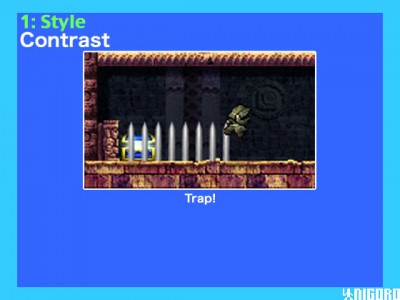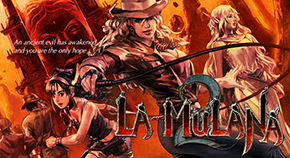Thanks everyone who came to listen my speech!
For the people who think “How could I go to Taipei!”, I am going to upload the entire address.

感謝貴單位的邀請。
我是來自遊戲獨立開發NIGORO的圖像與執行代表楢村。
雖然我們不是APP遊戲的開發者,但希望能以同樣是以小團隊獨立開發遊戲的立場,分享我的經驗。
首先讓我簡單地介紹NIGORO。是由三個對於製作詼諧遊戲有興趣的人,五年前以遊戲販賣為目標而成立。
首先為了先打響NIGORO的知名度,我們用了兩年的時間開發免費的Flash遊戲。
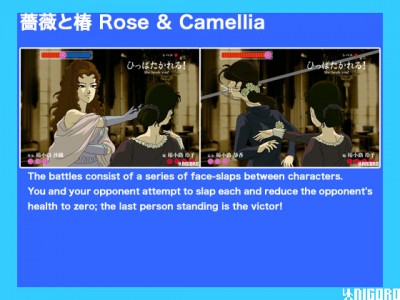
代表的作品就是「薔薇と椿」(媳婦甩巴掌)。是一款女生間以甩巴掌為題材,一對一的格鬥遊戲。也因為這樣的作品,使NIGORO在國際間稍稍地增加了知名度。
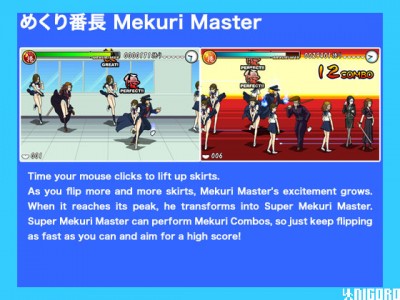
同樣廣受好評的作品「めくり番長」是一款掀女學生裙子的遊戲。目前在App Store也有類似的作品,讓我們有點困擾。
我們的著手點是,以免費的Flash game吸引玩家累積知名度,再開始販售付費的遊戲。
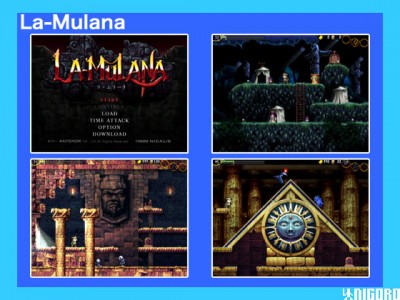
La-Mulana就是第一款我們的付費遊戲,共有WiiWare及Windows兩個版本。
另外我們也想儘快在日本的獨立遊戲市場站穩腳步,因此正在製作一款射擊遊戲。我們過去也曾經企劃過以智慧型手機的遊戲,但因為時間與人員等資源有限的情況下,還沒開始實行。
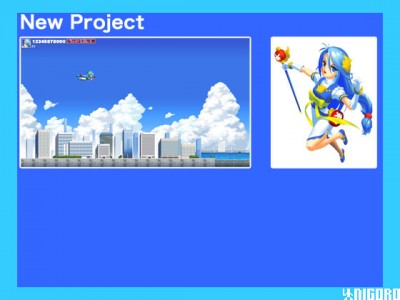
我並沒有固執於製作某些平台的遊戲,如果想製作的東西是適合智慧型手機,就會考慮開發手機遊戲。因此,如果我們過去的經驗能提供各位行動裝置遊戲開發人員的參考,那就太好了。
身為一個獨立遊戲製作的團隊,想向各位行動裝置遊戲開發人員分享的有以下兩點。

一個是Style,另一個是市場。
首先Style,也可以說是「製作遊戲的特色」。
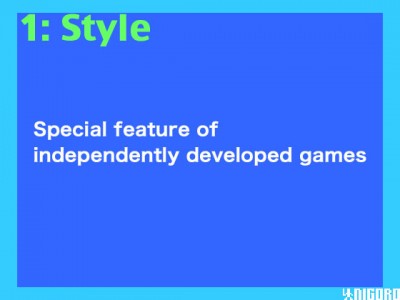
獨立遊戲也可以透過像是Steam這種網路遊戲服務與一般市售的遊戲競爭。今後將會有越來越多大型遊戲公司加入行動裝置遊戲市場,品質也可能會越來越高。
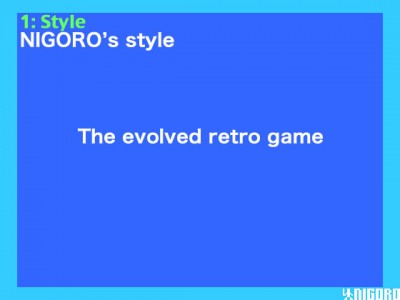
在這樣的市場下,要如何確立自己遊戲的特色呢?我們NIGORO選擇的Stlye是「復古遊戲進化版」。
製作團隊人數不足而無法製作大型的3D遊戲,但卻可以擁有不輸給大型遊戲公司或同樣競爭者的特色。既然身為獨立遊戲開發者,我們想要製作的是大型遊戲公司不會花費太多心力開發的復古遊戲。
我們所開發的遊戲La-Mulana被評價為「難度太高,不適合所有玩家」。也就是說被認為是以某一個族群為目標所開發的遊戲。
當然,也我們也不是一味地增加遊戲的難度。我們有很認真地調整難易度增加遊戲的趣味性。確定了遊戲的特色了以後,如果遊戲不有趣也沒有意義。以下就以La-Mulana做為比喻。
我認為遊戲之所以有趣,重要的元素就是「對比」。
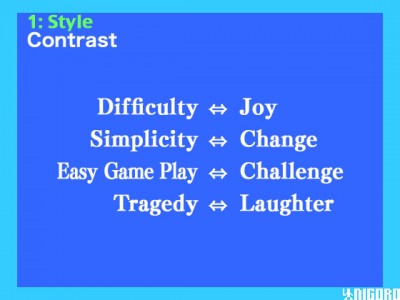
遊戲是創造出來給人玩的,因此這樣的「對比」會造成心情上的起伏。突破遊戲的「難關」後,所帶來的「開心」、「單調」之後給予玩家「激烈」的操作模式。我們認為以這樣的操作模式做不同的排列組合,可以讓玩家感受到興奮。以下就以我們的遊戲La-Mulana作為例子說明。
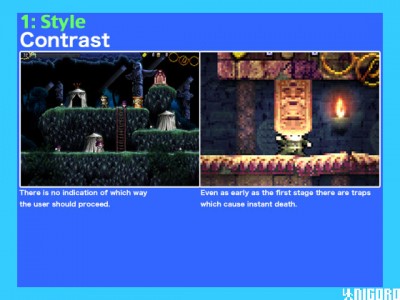
遊戲一開始玩家找不到遊戲指示也沒有任何限制的區域,玩家可以在遊戲裡恣意亂走,一個不小心就掉進陷阱、結束遊戲。這樣的遊戲設定,確實使許多玩家在這個階段就放棄遊戲。
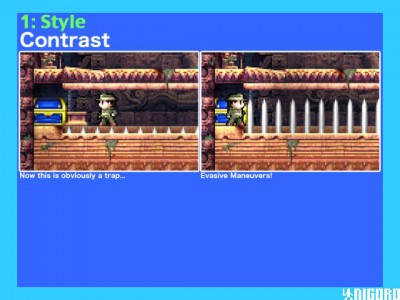
但一旦了解這不是一個「只要練等、亂闖就可以輕易過關」的遊戲,玩家就會慎重地蒐集線索,推理之後再謹慎地操作。推理後解出謎題的樂趣、迴避致命的陷阱,慢慢的累積遊戲的經驗。
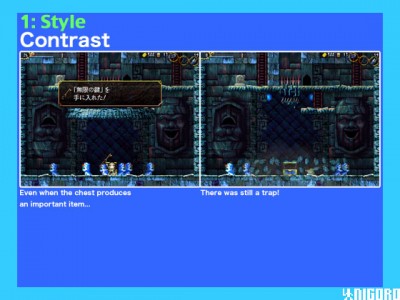
只是當慢慢上手後,正在得意洋洋,其實還有更深的陷阱正等著玩家。到了這個地步,玩家並不會生氣。「喔不!又中了!是我自己太不小心了!」,反而會讓玩家不由自主地笑了出來。首先,先給予玩家「不明確指出遊戲的目的地」的難題,在給予「根據提示解開謎題」的快感。
另外設置「難關」或是「強敵」,突破這些難關就可以得到「腳色的強化」或是「方便的功能」。這樣的遊戲設定,一次一次擴大心情上的對比,提供玩家不斷地維持在興奮的狀態。若是沒有這樣的平衡設定,就算遊戲難度在高,我想也不會讓玩家感到有趣吧。
對於不熟悉這款遊戲的人,我在簡單地舉例說明。
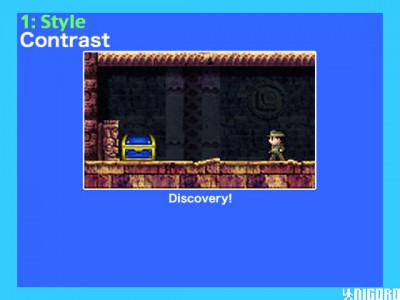
在沒有敵人的房間發現物品。
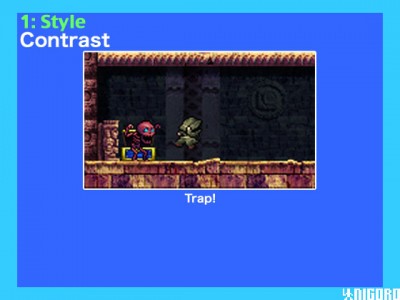
從寶箱中出現敵人,而結束遊戲。
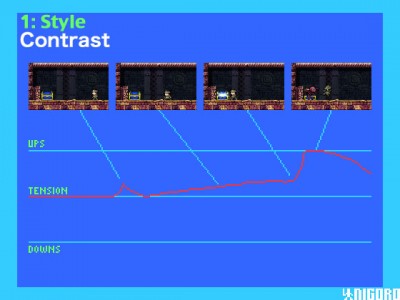
用圖表來表示,在沒有敵人「平静」的狀態下以「期待」「發現」的心情靠近寶箱(陷阱)。這樣的場景會造成感情的波動。
我們試著用另一種情況來驗證看看吧,

在沒有敵人的房間發現物品。
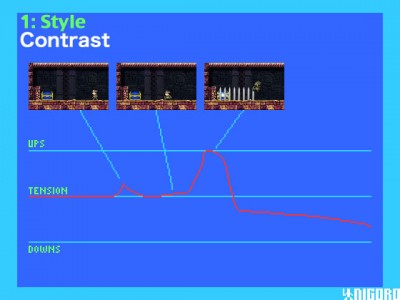
這個例子當中,對比就是「平静」「發現」接著而來的「陷阱」。之前看到的情感變化圖表是以一下上升一下下降的操作模式,但在這個情況下就在情感上生後瞬間下降的落差。像這樣自己操縱腳色,在毫無感覺下,情感已經跟著遊戲起伏。也被認為是會讓玩家上癮的重要因素。
接著再來一個極端一點的例子,一樣的開頭,

在沒有敵人的房間發現物品。
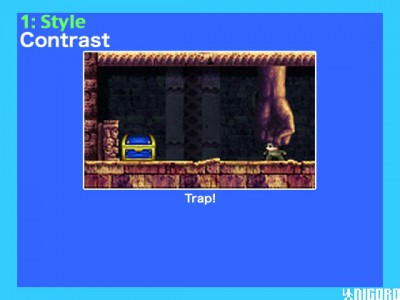
然後就死了。
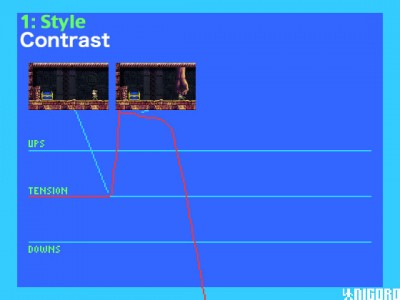
在這個例子當中,在沒有敵人的平靜,到陷阱的落差是最令人情感起伏最大的,但是,這樣的情況一直不斷重複也是會讓玩家感到厭煩的。相反的若是一直維持平靜的狀態,很不容易死掉,也很容易讓玩家感到厭倦。
我想像這樣的操作不管是怎樣的遊戲都可以適用的。App遊戲以益智類型居多,因此我以俄羅斯方塊來做比喻。
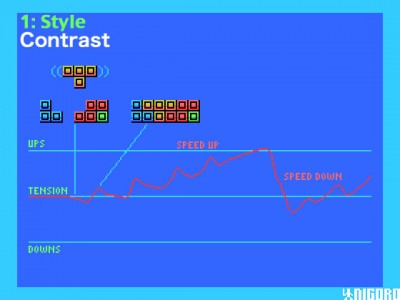
俄羅斯方塊是一種將方塊插入空隙中,將方塊消失而產生「快感」的遊戲。簡單的規則,但是因為對比的表現很好,隨著遊戲的進行增加速度,使玩家的興奮程度越來越高。持續著高速的狀態一段時間後,再回到較慢的速度。在玩家感覺到彈性疲乏之前,再次回到平穩的狀態。掌握這樣「情緒的波動」,就是製作出好玩遊戲的秘訣。
增加遊戲機能比較表面,但考慮到遊戲是一種互動的藝術。像這樣讓「玩家心動」的部分是不可或缺的。我們就是抱持著這種想法製作遊戲的。秉持著這種想法而製作的遊戲,就是我們NIGORO的Style。

接下來我們開始討論市場。因為是小團隊製作的遊戲,也必須自己負責販售的部分。
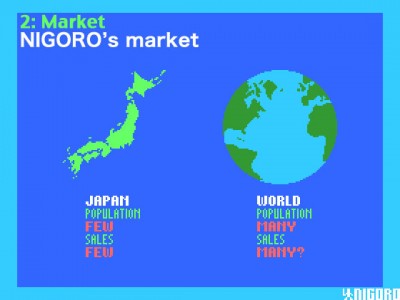
由於遊戲的銷售量在日本國內的成長有其限制,因此我們必須思考如何將遊戲銷售到日本以外的地區。
而La-mulana這款遊戲在一開始就設定為多語言的產品。
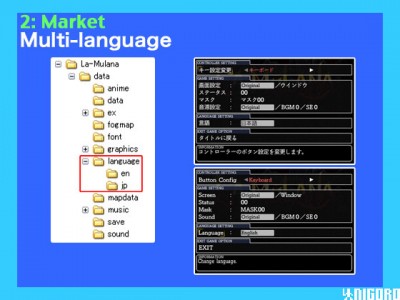
遊戲中的訊息、選單中的選項或是圖像中的文字,都歸類在一個語言包當中。只要增加語言包,就可以自動的切換語言。
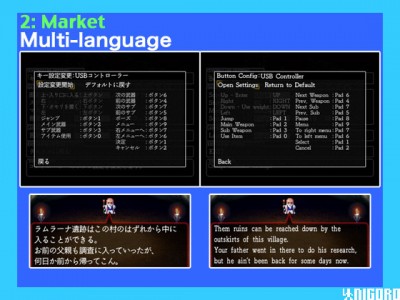
為了避免語言轉換時容易發生的問題,因此本遊戲使用uni-code編碼。遊戲中使用的字體也壓製成圖片,防止亂碼的產生。日文與英文的baseline也會轉變。
La-Mulana在選單的地方遇到了相當大的問題,因為項目是以日文為基準所製作的,當項目的名稱更改為英文是完全無法讀取,後來是將箭頭圖像化後才硬是解決了這樣的問題。才硬是解決了這樣的問題。
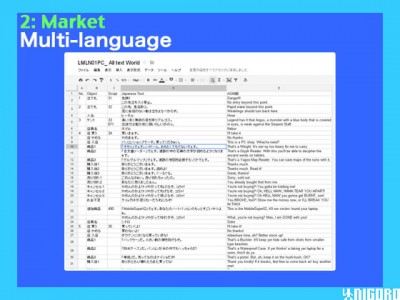
文字內容皆彙整於Google文件中,方便本公司的負責人與翻譯者直接於線上進行溝通連絡。
La-mulana最早是經由美國的玩家自行翻譯後,才廣為海外的玩家所熟知。
如果遊戲的語言及購買網頁若是以該國家的語言呈現,我想就算是海外的遊戲,有興趣的玩家應該也少吧。
公開遊戲文字稿,若是得到其他各國玩家的翻譯,應該可以將版圖擴展更大吧。
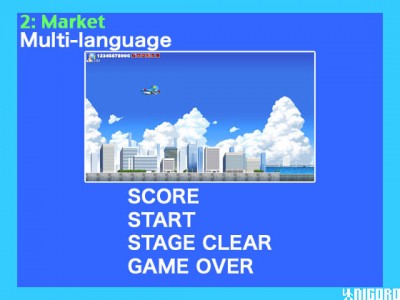
現在我們製作中的射擊遊戲,只要看得懂最簡單的單字就可以進行,是一款容易推向全世界的遊戲。這也是沒有說明書的App遊戲所需要具備的。
App遊戲的操作多半是以點擊、滑動為主。操作的說明只要與其他遊戲開發者分享,應該就會減輕許多翻譯上的負擔。
我們認為遊戲的趣味在任何國家、不同種族來說都是不盡相同。雖然目前以歐美地區的拓展為主,但我們也很希望藉此難得的機會一舉將本遊戲推展至亞洲地區。比起無法了解歐美人士對遊戲的偏好而傷透腦筋,應該較能理解亞洲玩家們的喜好。
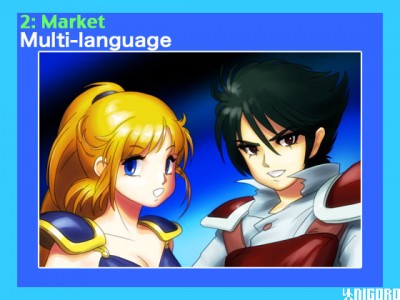
日本的遊戲繪圖
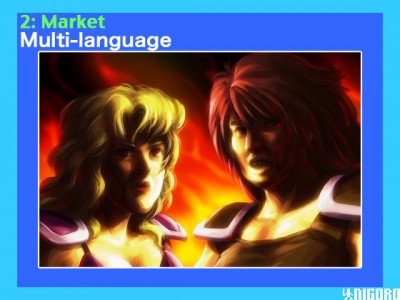
英文版遊戲的繪圖。
相信藉由此圖示,各位應該也不難了解前述的想法了。
如果可以的話,我們希望可以創造一個匯集亞洲遊戲、並且與在座各位的作品互相合作與競爭的地方。
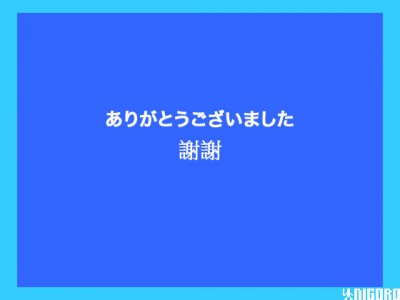
我的演講到此結束,謝謝大家。

Thank you very much for inviting us here today from Japan.
My name is Naramura, and I am the graphic director for NIGORO, the Japanese indie game developer team.
We don’t actually produce apps ourselves, but I hope that there are topics on which I can speak from the point of view of a developer of similar small-scale indie games.
First, I’d like to simply explain the work we do at NIGORO for those of you who may not know us.
Three of us who originally created games as a hobby got together, and from five years ago we began working as NIGORO with the goal of selling the games we created.
First, in order to spread the NIGORO name, we spent two years developing free-to-play Flash games.
I’d like to introduce a few of our more outstanding Flash game titles.

First, “Rose & Camellia”.
This is a fighting game in which women battle each other 1-on-1 by slapping each other. Thanks to this game’s popularity, our name became a bit more recognized throughout the world.

“Mekuri Master” was also well-received overseas. This is a shameless game in which you continue flipping up skirts.
We actually had some trouble with products similar to these two games being sold on the App Store without permission.
After improving our name recognition with the publication of Flash games, we moved on to the distribution of pay-to-play games.

For our first attempt, we were able to release our roaming action game LA-MULANA for WiiWare and Windows.
Currently, we are creating a shooting game and are working toward releasing this latest game as soon as possible in order to gain a foothold for our future activities.

In the process of aiming to distribute games, we had made plans to develop game apps for smart phones, but we were unable to allot the required time and manpower so we never got to execute those plans.
I don’t want to cling to any one specific platform, and I feel that if the game I want to create would be good for smart phones, then I want to develop it as a game app.
With that meaning as well, we hope that there is something in our activities that all of you app developers can take into consideration.
From our experience developing indie games, there are two things that I would like to propose to you all, as developers of similarly small-scale apps.

The first is style, and the second is the market.
First, “style” can also be said to be “the distinctive features of one’s own games”.

With indie games, entrusting your games to distribution services such as Steam means doing battle with software from major commercial distributors in the same market.
From here on out, more major distributors will participate in smart phone app sales, and looks, quality, and volume will all be compared with commercial games.
I think it is imperative to have your own original style which makes people think “I want to buy this game” even among these circumstances.

The style that we at NIGORO chose was “evolved retro games”.
Our development staff consists of three people. With a team this size, we can’t create large-scale 3D games, and it’s obvious that we would lose if we were to take on major commercial distributors with style similar to theirs.
We felt that since we’re working as indie developers, we should pursue the sort of thoroughly produced retro-style games that more major developers don’t make.
There are a lot of games with retro-style graphics and sound, but there are not many games with volume which are actually created in the retro style.
Apparently, our game LA-MULANA is said to be “too hard, and not for everyone”.
However, put a different way, it could be said that it’s been well-received by exactly the kind of players we were aiming for.
Of course it’s said to be difficult, but it’s not that we are just randomly raising the difficulty level to prevent players from clearing the game.
We’ve put care into creating the kind of balance that allows people to feel that the game is fun specifically because of its level of difficulty.
If a game is too difficult then players will give up, but with the right balance it’s possible to create a game with “the sort of fun that wouldn’t be possible without this difficulty level”.
Establishing your own style is important of course, but if a game isn’t fun, then it’s pointless.
Here I’d like to explain how we think of the fun aspect of games, using LA-MULANA as an example.
This is the keyword we keep in mind when creating the fun aspects of a game.
The important keyword to consider when making a game fun is “contrast”.

Unlike animation and movies, games are controlled by the people playing them.
Here, “contrast” is necessary to change the player’s emotions, to excite them, and to immerse the player in the world of the game.
People’s emotions rise and fall when something is sad or enjoyable. We try to make games so that they continually provide the contrast necessary to provide the player with these ups and downs.
Here is an example.
To advance through an action game, you need to get used to the controls. It’s difficult until you get used to them, but once you get past that point, fun and happiness await.
If the controls stay too simple for a long time, it gets boring, but if quick controls are suddenly required, the player will panic.
When a sad event occurs in the scenario, it feels like more of a shock the more happy the preceding scene was.
This refers to providing the contrast required to provide the player with emotional ups and downs.
Players don’t simply get excited just because you created a game. If the creator doesn’t provide the player with an exciting system, then nobody will think that your game is fun.
We mix a number of elements such as system, controls, graphics, music, and scenario to provide a variety of changes and contrasts.
I’d like to explain using our game LA-MULANA as an example.

With LA-MULANA, when you start the game there are no directions regarding which way to go and no restrictions on movement, and it’s easy to get a game over in areas where the creators didn’t want you to proceed further.
Recently, there are a lot of games which guide you along kindly at the beginning, but in this game there are deadly traps from the beginning stages.
There are actually players who gave up and quit the game at this starting point.

However, at this point people who understand that “this is a game in which acting without thinking can be fatal” think harder about their movement and look for hints to plan their moves.
Once those plans work out and players feel the pleasure of opening up a path, they acquire experience and the skill to avoid traps ahead of time.
This is the “contrast” I just explained, for which you provide difficulty at the start, allowing the player to realize the fun of the game once they’ve overcome that.
It would also be possible to make it into a game in which you allow the player to proceed while guiding them along, but I think it would take a great deal of time to provide the fun in the early stages of LA-MULANA.
Of course this difficulty level was planned and created. We’re sometimes told that the game is unfriendly, but we’ve kept a balance that is naturally noticeable after playing a few times.
This type of trap isn’t in the very beginning, with relatively simple ones at the start, turning into more complicated and difficult traps which deal greater damage as you go along.
Then, when you’ve gotten used to the game and have acquired plenty of skills, immediately after the reward, there are deadly traps lying in wait.

Once users have gotten this far, they don’t feel angry at the game. They think “it was my fault for faltering!”.
I’ve seen many videos players have publicized of themselves playing, and everyone gets surprised, frustrated, and finally laughs at this scene.
I think that this is the result of us trying to let people feel that the game is fun even with the high level of difficulty.
LA-MULANA is a game in which the map is large and it takes time to clear it, and it is impossible for the player to predict which way they will proceed.
However, even with many different paths to follow, if there’s one simple path among a bunch of difficult ones, then players will naturally follow the simple one.
Instead of covering up the hard parts from the start, we have to make it so that the player thinks that they chose the path themselves after experiencing the hard parts.
Then, once they’ve gotten past the hard parts and tough enemies, they are provided with “character enhancements” and “useful functions”.
This makes the contrast larger as the game proceeds, and allows for a continuing string of parts that keep the player excited.
We feel that if this balance is correct, then you can get the player to feel that the game is fun even if the difficulty level is high.
I’ll explain it a bit more concretely, using a scene from the game as an example.

The player finds an item in a room with no enemies.
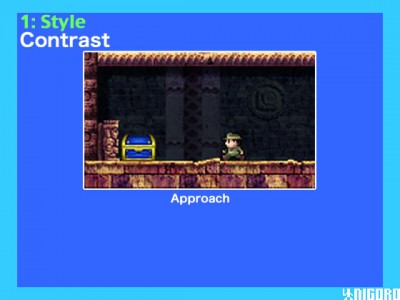
The player moves closer to the treasure chest.
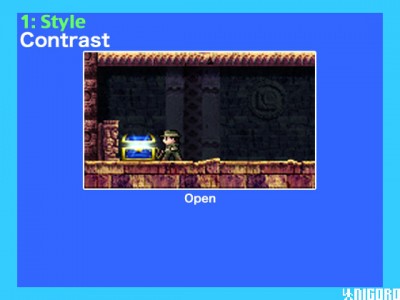
The player opens the treasure chest.

It’s actually a trap, and a monster appears from inside.
Now we’ll check to see what kind of contrast is provided and how much emotions change.

In a “calm and tranquil” Room with no enemies, a treasure chest is found providing “expectation”, and once you get excited and move closer to it, it turns out to be a “trap”. This is how emotions change in this scene.
The points are the “joy” when finding the treasure test, the “expectation” that builds when you move closer to the chest, and the “shock” when those expectations are betrayed.
This is the contrast that the game provides, which affects the player’s emotions.
Let’s try changing this scene a bit.

The player finds an item in a room with no enemies.

The player moves closer to the treasure chest.

In this case, differing from the first example, the player feels shock before their expectations build.
The player may be more surprised with this version, but I think that building expectation increases both surprise and frustration exponentially.
Conversely, it gets the player down when they are dealt damage even though they haven’t made any mistakes.
This is an example of how a game’s rendition and timing can cause a player’s emotions to change differently even with similar scenes.
I’ll provide another extreme example.

The player finds an item in a room with no enemies.

He dies.

In this case, the player is shocked by a cheap shot while they feel “calm”, so I think that this provides the most jarring change in emotion.
But repeating this will cause the player to hate the game, so you can’t just change the player’s emotions at random.
For nicer games, it’s rarer to get a game over and the player doesn’t get nervous.
We thought that this would lessen the joy of clearing the game, so we made LA-MULANA with the hopes that it would be called a difficult game.
I think it gets boring if it’s just a continuation of fun, pretty, and happy.
Up to this point, this hasn’t been only about action games; I think it is applicable to any kind of game.
There are a lot of puzzle game apps, so next I’ll try explaining using Tetris as an example.

Tetris is a really well-made game. The rules are really simple, but there are plenty of “contrasts” and “changes” in the game.
First, there’s the “difficulty” of thinking about where to move the blocks, and when you erase the blocks, you feel the “fun”.
While the rules are very simple the contrast is done very well, and the game speeds up as you go along.
It’s a game with a lot of repetition of simple contrasts, but as the speed changes the way you feel and the way you get excited change as well.
After handling the high speed action for awhile, it goes back to slower speed again.
After emotions run high, the game reverts the player back to a more calm state just before the situation becomes too hard.
I think that this way of including “emotional ups and downs” in a game is the secret to creating a fun game.
As the abilities of gaming machines improve everyone talks about beautiful graphics and effective controls, but if you feel that games are interactive art for people to play with, then you need to create these “parts that move the player’s emotions”.
Thinking thoroughly and keeping this in mind when creating games is our “style” at NIGORO.

Next I’ll discuss the market.
As long as you’re producing with a small number of people, you’ll need to find ways to sell the game on your own.

We’re Japanese, so we want to sell games in Japan, and we want our games to sell well in Japan.
However, the Japanese population is small, and the custom of downloading and purchasing games has not spread much, so we can’t reach our sales goals in Japan alone.
We had to sell the game overseas to meet our sales goals, and so we had to prepare an English version.
Therefore, we developed LA-MULANA with multilingual specs from the start. We made it so that we could display languages other than English as well as long as the languages were prepared.

Not only the in-game messages, but the text displayed in menus and graphics shown in renditions are all bundled into a single language set.
We made it so that the language could be automatically switched if more language sets are added.

In order to avoid font problems, we made all of the text used into images.
When displayed, the word length is checked and the display position changes.
For English, it automatically implements line breaks to avoid having words get cut off.

All text used in the game is up on the internet on Google Docs.
We used this to work with the translators.
By sharing the data online, all members of the development team were able to check the text, and publicizing this data also allows others to translate the text into other languages as well.
LA-MULANA was originally translated by fans in North America, and thanks to them
we were able to spread out overseas.
If the game text and distribution page are in one’s own language, I think that many people would make the decision to try buying a game from overseas.
Open sourcing the game text and allowing fans to translate it into different languages may allow it to spread out to many different countries.
Translation work gets harder the more text there is, so it may be smart to make
games with little text used.

For the shooting game we’re currently working on, as long as the player can understand
these words, they can play the game. The translation is easy and it would be easy to
distribute the game to many different countries.
However, for apps which cannot contain an instruction manual, information such as control methods, etc. is required.
But most controls such as touching and sliding are common among apps, even among different games.
If developers would share text such as control explanations with each other, I think that
could help reduce the translation workload.
In Japan, we’re working hard to get games to sell in the US and Europe, but we sometimes don’t know what Westerners like, and problematic items differ from country to country, so it can get difficult.
Recently, I have started to think that if you’re going to go through the trouble of getting
a game out in the West, then it may be more simple to try for Asia, which also has
many users.
Asia has more countries and more languages than the West, but conversely, apart from the language barrier, I think that people from close countries may be able to better understand each other.
We are currently focused on spreading into the West, but with this opportunity to come here and speak with you I feel I’d like to spread into Asia as well.
It should be easier to understand the preferences of people from closer Asian countries than people from the West.

For example, when selling a game with this sort of image in the West,

wouldn’t it be easier for people from Asian countries to understand each other than thinking of what kind of image it would become in the West?
I would love it if we could have a place apart from the West where Asian games could gather and I could compete with the works of the people here.

That’s it for my presentation. Thank you very much.
